Postgraduate student Finn Adams shares a selection of arms and armour of antiquity which can be found in New Zealand collections. The selection is drawn from the survey he completed as a PACE 495 intern at the UC Teece Museum in 2021.
During the first semester of 2021 I began an internship with the University of Canterbury Teece Museum through the PACE 495 course. The project I undertook was to create a resource which catalogued all the known examples of arms and armour of antiquity currently held in New Zealand collections. I hope the resulting resource will be of value to researchers who are as fascinated by ancient arms and armour as I am, and will also be useful for teachers or students investigating ancient warfare.
The completed resource contains over sixty artefacts from a variety of museums and collections. Each item appears with catalogue information provided by each institution as well as my own personal interpretations, which added any other necessary information about the objects. The process of finding all these objects differed for each artefact, but generally most were discovered by contacting museum staff or private collectors directly. Once an artefact was added to my list, I attempted to research as much information as I could about each type of weapon or armour. The final product includes all the artefacts and information about them compiled into a list, which has been broken down into three main sections – ‘projectile and throwing weapons’, ‘edged and bladed weapons’, and ‘armour’. In this post I would like to share two artefacts from each section that I think are particularly noteworthy.
Spear Point (Arrowhead)
Arrowheads made up a large chunk of the final resource and therefore I thought at least one should be included here.
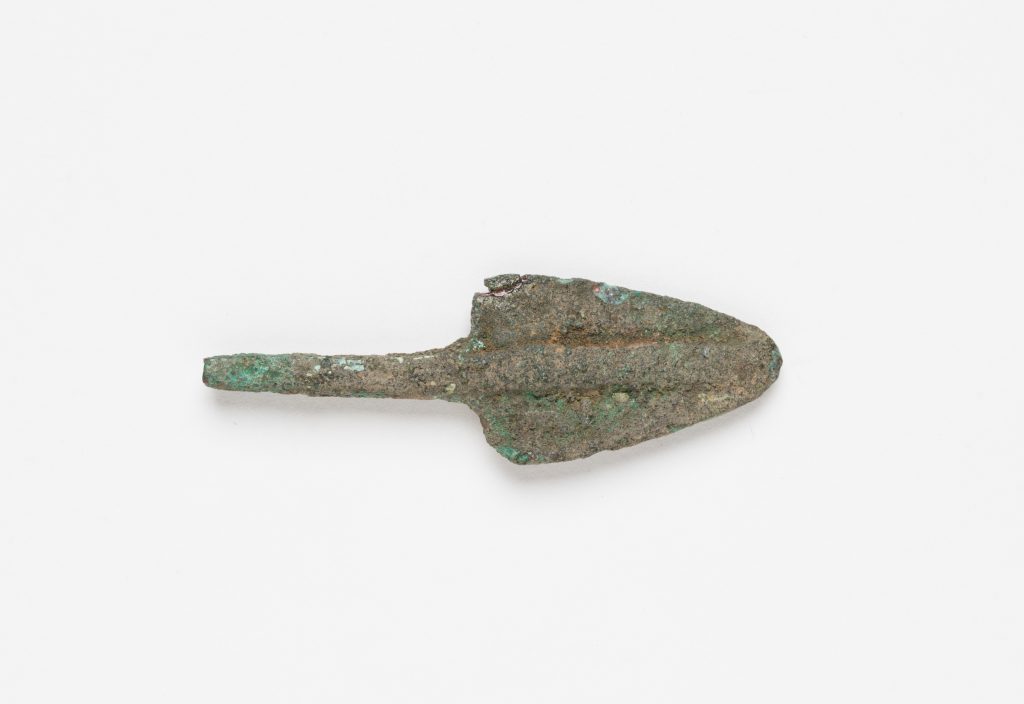
This artefact is more likely to be an arrowhead rather than a spear point, as suggested by its original catalogue entry, given the shape of the item and its small size at just 57mm long. It is possibly a bilobate (i.e. double lobed) arrowhead shape with a tang. The completed arrow would have been formed by the tang being inserted into a reed or a hollow wooden shaft.
Although the original catalogue entry states that it is of Greek origin, the shape suggests it may be an Achaemenid-Egyptian variant of the bilobate arrowhead dating from 550 to 400 BCE. The catalogue information does not state where this particular arrowhead was found but it is possible that it was attributed to the Greeks simply because it was originally found in Greece. If this is the case, it is possible that the arrowhead ended up in Greece during the Achaemenid invasion of Greece which occurred around the time to which the arrowhead is dated. However, this is just speculation.
Slingshot
I found this slingshot bolt (or bullet) interesting as there is a possibility that it could have been used in the famous rebellion of Queen Boudica. It is also one of the few artefacts from the UC Teece Museum’s collection included in the resource, so I was able to study it in person.
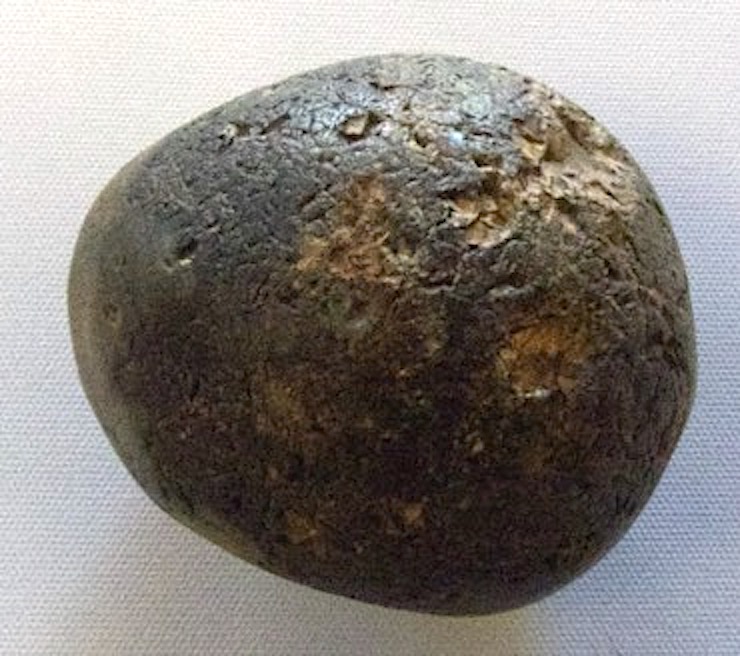
This artefact is most likely a slingshot stone, as it has been identified in the Teece Museum database. This slingshot bolt was probably used for warfare, due to it being larger than bolts which were typically used for hunting. The catalogue notes suggest that the stone came from Colchester, in England. If this is correct, then the bolt most likely belonged to a native Briton rather than a Roman due to its lack of design and the fact that it is made of stone (rather than lead, which is what the Romans used).
Roman rule in Colchester, (known as Camulodunum to the Britons and Colonia Victricensis to the Romans), lasted from about the 1st century to the 5th century CE so, the slingshot probably dates in between that timeframe. Most of the fighting between Britons and Romans in the Colchester area took place in the 1st century CE. It is even possible that this bolt was used in the rebellion of Boudica, (Queen of a Briton tribe, the Iceni), as Colchester was attacked and destroyed by the Britons in 61 CE. We know that slingshots were used for attacking strongholds at that time, so this is an interesting possibility.
Axe
This ancient axe is particularly interesting as its provenance can be accurately pinpointed, which is uncommon when dealing with antiquities. I was fascinated to learn that the axe was found in the short-lived capital of Amarna built by the Pharoah Akhenaten, whose wife was the now famous Nefertiti.
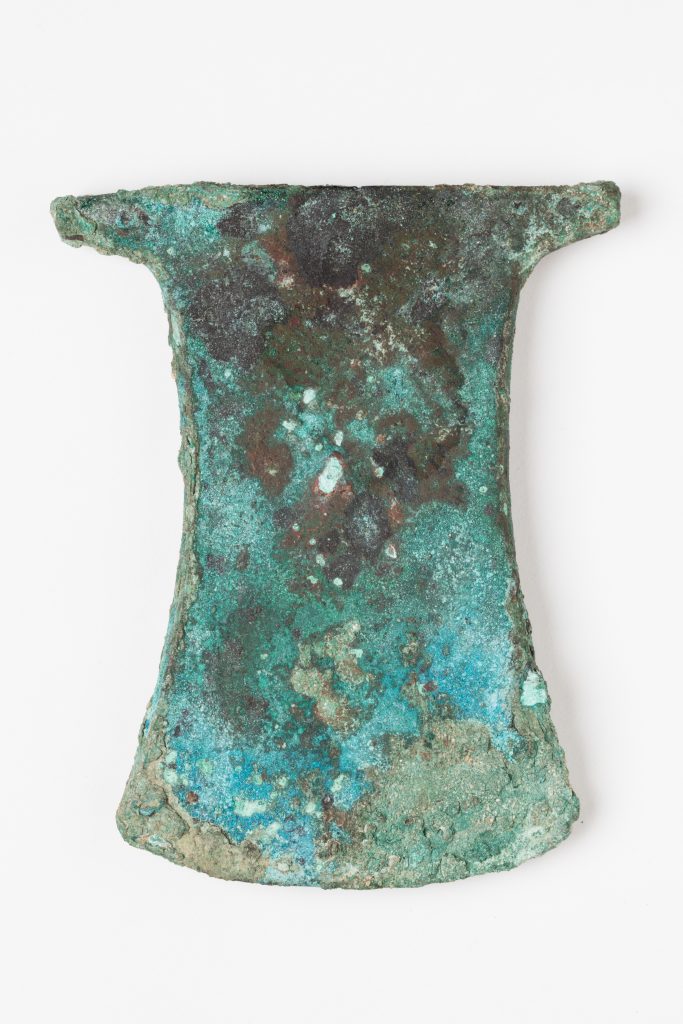
This axe head was most likely part of a battle-axe. To make it functional, a pole would be inserted through the two lugs. According to the Auckland Museum catalogue, the axe head presumably was found at the site of Amarna in Egypt. This means its date can possibly be narrowed down to a range of 15 years from 1347-1332 BCE, as Amarna was said to have been inhabited only for this short time. However, it is possible that the date range could be slightly wider as people probably inhabited Amarna just before it was completely built and a little after it had been abandoned.
Amarna was built in 1347 BCE during the eighteenth Egyptian dynasty by Pharoah Akhenaten as his new capital. Just fifteen years later, after Akhenaten’s death, Amarna was abandoned. An almost identical axe head found at Amarna in the Brooklyn Museum collection can be used for reference. Brooklyn have their axe dated to circa 1353-1329 BCE. (see https://www.brooklynmuseum.org/opencollection/objects/3302)
Dagger
This electrotype dagger is a remake of one of the most impressive Mycenean weapon finds, in my view. Although it is not an original, the electrotype is still exceedingly well made and gives the viewer a better understanding of what the original would have looked like when first made.
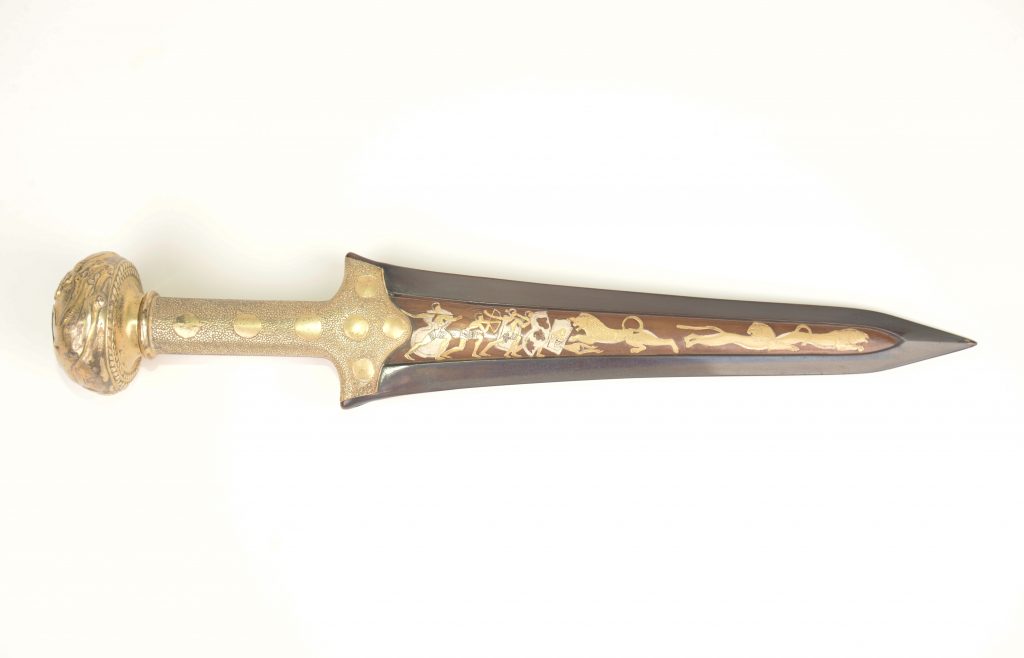
This dagger is known as the ‘Lion Hunt dagger’ and is one of several electrotypes produced by the Gilliérons in Württemberg at the start of the 20th century CE. This electrotype was probably made between 1900-1908. The replica is known as a ‘galvanoplastic’ model, (which is an alternate term for the electrotyping process). The original Bronze Age Mycenaean dagger, which features a scene of warriors hunting lions, is currently in the National Archeological Museum of Athens. The original dagger would have been made as a grave good, specifically to be placed with the deceased in a burial.
Samnite Bronze Suit of Armour
This bronze suit of armour is rather intriguing, as it is one of the few suits of ancient armour held in New Zealand and the only set that includes greaves.
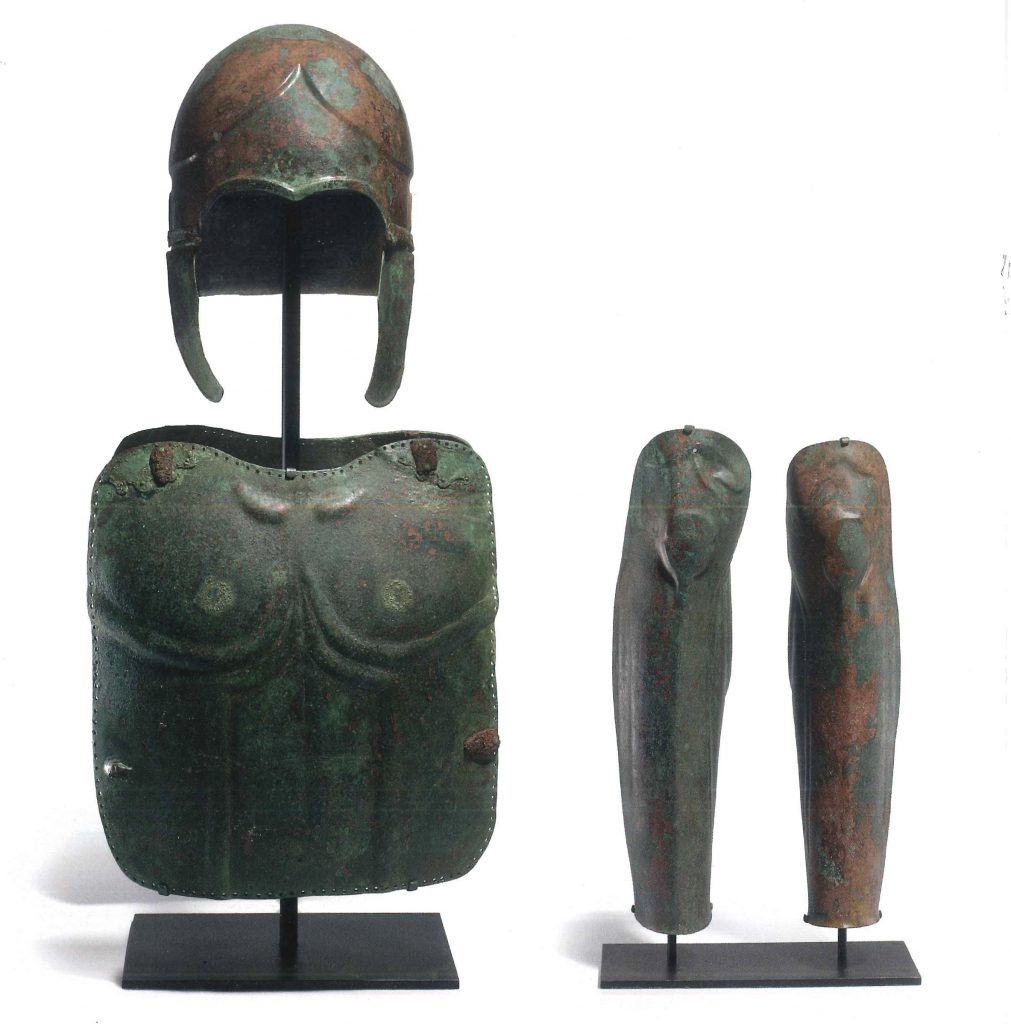
This Samnite suit of armour was fashioned from hammered sheets of bronze, and is comprised of an “Attic type” helmet, corslet and greaves. The Samnites were an Italic tribe from Southern Italy and were a constant enemy to the nearby Romans, who subjugated them in 321 BCE. This particular suite of armour could have possibly been worn by a warrior fighting against the Romans as it dates to the 4th century BCE, when Rome was often at war with the Samnites.
The Attic helmet in this suit was a style developed by the Athenians in the 6th century BCE. It is thought that lighter helmets like the Attic became popular around 530 BCE in Greece. Most Attic helmets were not much more than a skull cap by themselves, but this helmet also has hinged cheek pieces attached. There is no neck guard attached to this helmet, which was common, although it may have detached. The Attic style of helmet is the helmet that the goddess Athena is usually depicted wearing. This style of helmet, and its variants, was in use until 400 CE, commonly used by the Romans.
Illyrian Greek Bronze Helmet
This final item, an Illyrian helmet, is currently on display at the Teece Museum, and I had the opportunity to study it first-hand. This is also one of the two helmets I focussed on for the PACE 495 research essay, so I am well acquainted with it.

The design of this style of helmet was likely Peloponnesian in origin and was popular in Greece up until the sixth century BCE. The first group of this style of helmets was made using two bronze pieces, and dates to the period from 700-640 BCE. This particular helmet is made from just one piece of bronze, so the helmet is definitely more recent than 640 BCE. This helmet also has no ear cutouts, so it is probably not a late version of the helmet, thus a date of late 6th century BCE is probably reasonable.
The Illyrian helmet was very popular in Northern Greece and the Balkans after the mid-6th century BCE and was in use there for a few more centuries after it had died out in Greece by the 5th century BCE. The popularity of the helmet in these areas explains why it is referred to as ‘Illyrian’, which was the name one of the larger Balkan tribes. Since the helmet is probably from the 6th century BC, it is difficult to say where it was used for certain, although it was most likely manufactured in Greece.
Conclusions
These are some of the items that I personally found interesting and had a great time researching during the PACE 495 internship at the UC Teece Museum. They demonstrate the surprising range of ancient arms and armour that are held in New Zealand collections. Furthermore, I was even more surprised by the total number of items identified in my research, as this far exceeded what I predicted we might locate.
Overall, I was very pleased with the end result of the project, and I believe that the resource definitely holds some interesting information about ancient arms and armour in New Zealand. I hope that this snippet of the finished resource shared here adequately affirms this.
Finn Adams is currently studying to complete a Master of Arts in History at the University of Canterbury and is a Gallery Host at the UC Teece Museum. In 2021 he completed a Bachelor of Arts with Honours in Classics. Part of his course of study included working as a PACE 495 intern at the Teece.
Acknowledgements:
Sincere thanks to the following organisations and colleagues for their assistance in the creation of this resource:
-
- Auckland War Memorial Museum Tāmaki Paenga Hira – Deirdre Harrison, Louise Furey, Anna Beazley
- Canterbury Museum – Daniel Stirland
- Doug and Anemarie Gold
- Tūhura Otago Museum – Moira White, Jen Copedo
- Museum of New Zealand Te Papa Tongarewa– Claire Regnault, Carolyn McGill
- University of Auckland – Jeremy Armstrong
- University of Canterbury Teece Museum – Terri Elder
- Victoria University of Wellington – Diana Burton